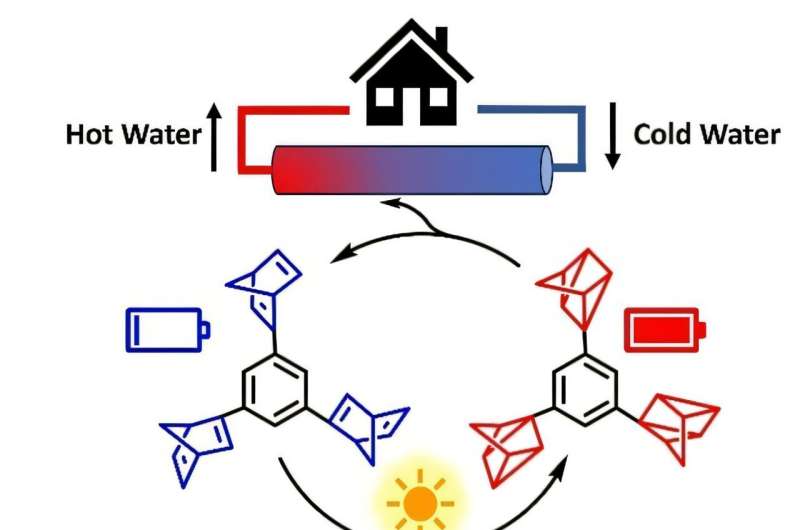
October 29, 2024 by Kathrin Voigt, Johannes Gutenberg University Mainz
Collected at: https://techxplore.com/news/2024-10-photoswitch-approach-paves-harvesting-solar.html
As stated by the International Energy Agency (IEA), approximately 50% of global final energy consumption is dedicated to heating. Yet, the utilization of solar power in this sector remains relatively low compared to fossil energy sources. An inherent problem limiting the widespread usage of solar energy is the intermittency of its direct availability.
A promising solution comes in the form of molecular solar energy storage systems. Conventional thermal energy storage strategies store the energy for short periods, e.g., in the form of hot water. In contrast, molecular solar energy storage systems store solar energy in the form of chemical bonds, allowing it to be preserved for several weeks or even months.
These specialized molecules—or photoswitches—absorb solar energy and release it later as heat, on demand. However, a key challenge for current photoswitches is the trade-off between energy storage capacity and efficient absorption of solar light, limiting the overall performance. To overcome this issue, research teams at Johannes Gutenberg University Mainz (JGU) and the University of Siegen present a novel approach in a collaborative study.
The results have been published in Angewandte Chemie International Edition.
Decoupling the absorption and storing processes of solar energy
The novel class of photoswitches was first introduced by the group of Professor Heiko Ihmels at the University of Siegen, demonstrating exceptional energy storage potential comparable to conventional lithium-ion batteries. However, their functionality was initially limited to activation by UV light, which constitutes only a small portion of the solar spectrum.
The research teams at Mainz and Siegen have now introduced an indirect light harvesting method, comparable to the function of the light-harvesting complex in photosynthesis. This incorporates a second compound, a so-called sensitizer, which exhibits excellent absorption properties of visible light.
“In this approach, the sensitizer absorbs light and subsequently transfers energy to the photoswitch, which cannot be directly excited under these conditions,” explained Professor Christoph Kerzig of the JGU Department of Chemistry.
This new strategy has increased solar energy storage efficiency by more than one order of magnitude, representing a major step forward for the energy conversion research community. The potential applications of these systems span from household heating solutions to large-scale energy storage, offering a promising path towards sustainable energy management.
Mechanistic studies essential for reaction discovery and optimization
The Mainz-based team of researchers led by Professor Kerzig and Ph.D. student Till Zähringer conducted detailed spectroscopic analyses to explore the complex system, which were essential for understanding the underlying mechanism. Each reaction step was carefully examined by the paper’s first author, Zähringer, resulting in a thorough understanding of how the system operates.
“By doing so, we could not only push the light-harvesting limit substantially but also improve the conversion efficiency of light to stored chemical energy,” explained Zähringer.
Under operational conditions, each absorbed photon can trigger a chemical bond formation process, which is rarely observed in photochemical reactions owing to several energy loss channels. The scientists successfully validated the system’s robustness and practicality by cycling between the energy storage state and the energy release state multiple times employing solar light, highlighting its potential for real-world applications.
More information: Till J. B. Zähringer et al, Triplet‐Sensitized Switching of High‐Energy‐Density Norbornadienes for Molecular Solar Thermal Energy Storage with Visible Light, Angewandte Chemie International Edition (2024). DOI: 10.1002/anie.202414733
Journal information: Angewandte Chemie International Edition , Angewandte Chemie

Leave a Reply